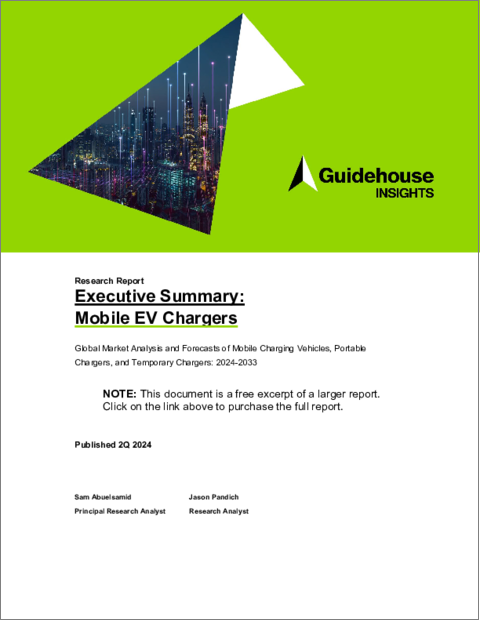|
|
市場調査レポート
商品コード
1477958
移動式EV充電器:移動式充電車両、ポータブル充電器、一時充電器の世界市場の分析と予測 (2024~2033年)Mobile EV Chargers - Global Market Analysis and Forecast of Mobile Charging Vehicles, Portable Chargers, and Temporary Chargers, 2024-2033 |
||||||
|
|||||||
| 移動式EV充電器:移動式充電車両、ポータブル充電器、一時充電器の世界市場の分析と予測 (2024~2033年) |
|
出版日: 2024年05月09日
発行: Guidehouse Research
ページ情報: 英文 36 Pages; 28 Tables, Charts & Figures
納期: 即納可能
|
全表示
- 概要
- 図表
- 目次
プラグインEV (PEV) の普及に伴い、強力なEV充電エコシステムが必要となります。PEVの初期導入者のほとんどは、家庭用充電器で充電ニーズを満たしてきましたが、PEVの普及が進むにつれて、公共充電ソリューションのニーズも高まると思われます。恒久的に設置された充電器は、ほとんどの充電ニーズに応えることができますが、送電線の容量の制限、送電網の更新コストの高さ、充電器設置の遅れにより、充電エコシステムにギャップが生じます。そのギャップの解消に用いられるのが移動式EV充電器で、柔軟な一時的充電ソリューションをこれで整備できます。
移動式EV充電器は、バッテリーパックや発電機を利用してPEVに充電を提供するEV充電市場の小さなセグメントであり、充電車両、ポータブル充電器、一時充電器が含まれます。移動式EV充電器は、その場所に簡単に運ぶことができ、送電網への恒久的接続無しで動作するため、オンデマンドやロードサイド補助に利用することができます。また、短期的な需要を満たしたり、緊急時に充電を提供したり、常設充電器の設置候補地の商業的可能性を評価したりするために、半常設的に配備することもできます。
当レポートでは、世界の移動式EV充電器の市場動向について分析し、全体的な販売台数と収益額の動向見通し (2024~2033年) や、技術別 (充電車両、ポータブル充電器、一時充電器など)・コンポーネント別 (バッテリー、非バッテリー)・地域別の詳細動向、新規販売される移動式EV充電器の潜在的設備容量と配備台数の見通しなどを調査しております。
目次
第1章 エグゼクティブサマリー
第2章 市場の問題
- イントロダクション
- 移動式EV充電器
- 充電車両
- ポータブル充電器
- 一時充電器
- 促進要因
- ロードサイド支援とオンデマンド充電
- 短期・緊急配備
- 現場での評価
- 恒久的な設置の代替
- 抑制要因
- 充電器の管理
- バッテリーの容量
- 環境への懸念
- 技術開発
第3章 産業バリューチェーン
- イントロダクション
- バリューチェーンの図解
- 競合情勢
- 企業合併・買収 (M&A) 活動
- ビジネスモデルの進化
第4章 市場予測
- 調査範囲
- 調査手法
- 主な前提条件と制限事項
- 制限
- 世界市場の分析結果
- 収益
第5章 結論・提言
- 3つの大きなポイント
- 推奨事項
- バッテリーサプライヤー
- EVSE (EV用充電スタンド) メーカー
- 自動車OEM・ディーラー
- 公共充電サービスプロバイダー
- フリートオペレーター
- 職場・MUD (集合住宅) オーナー
第6章 頭字語・略語一覧
第7章 目次
第8章 図表
第9章 調査範囲、情報源と調査手法、注釈
List of Tables
- Light Duty EVs in Use by Region, World Markets: 2024-2033
- BEV Medium and Heavy Duty Trucks in Use by Region, World Markets: 2024-2033
- BEV Buses in Use by Region, World Markets: 2024-2033
- Mobile EV Chargers in Use by Region, World Markets: 2024-2033
- Charging Vehicles in Use by Region, World Markets: 2024-2033
- Portable Chargers in Use by Region, World Markets: 2024-2033
- Temporary Chargers in Use by Region, World Markets: 2024-2033
- Mobile EV Charger Sales by Region, World Markets: 2024-2033
- Charging Vehicle Sales by Region, World Markets: 2024-2033
- Portable Charger Sales by Region, World Markets: 2024-2033
- Temporary Charger Sales by Region, World Markets: 2024-2033
- Mobile EV Charger Revenue by Region, World Markets: 2024-2033
- Charging Vehicle Revenue by Region, World Markets: 2024-2033
- Portable Charger Revenue by Region, World Markets: 2024-2033
- Temporary Charger Revenue by Region, World Markets: 2024-2033
- Battery Sales to Mobile EV Chargers Revenue by Region, World Markets: 2024-2033
- Battery Capacity of Mobile EV Charger Sales by Region, World Markets: 2024-2033
- Battery Capacity of Deployed Mobile EV Chargers by Region, World Markets: 2024-2033
List of Figures
- Mobile EV Charger Equipment Revenue by Region, World Markets: 2024-2033
- Mobile EV Charger Sales by Technology Segment, World Markets: 2024-2033
- Battery Sales to Mobile EV Chargers by Technology Segment, World Markets: 2024-2033
- Battery Capacity of Mobile EV Chargers Deployed by Region, World Markets: 2024-2033
- Mobile EV Charger Equipment Revenue by Component, World Markets: 2024-2033
- Charging Vehicle Equipment Revenue by Region, World Markets: 2024-2033
- Portable Charger Revenue by Region, World Markets: 2024-2033
- Temporary Charger Revenue by Region, World Markets: 2024-2033
Pictorial Representation of the Industry Value Chain
Regional Forecast Segments
The growing number of plug-in EVs (PEVs) on the road will require a robust EV charging ecosystem. Most early adopters of PEVs have satisfied their charging needs with home chargers, but as PEV adoption increases so will the need for public charging solutions. Permanently installed chargers can serve most charging needs, but limitations to grid capacity, high costs for grid upgrades, and delays in charger installations will create gaps in the charging ecosystem-gaps that can be filled by mobile EV chargers, which can provide a flexible and temporary charging solution.
Mobile EV chargers, which are a small segment of the EV charging market that utilize battery packs or generators to provide charging to PEVs, include charging vehicles, portable chargers, and temporary chargers. Because mobile EV chargers can be easily transported to a location and operate without a permanent grid connection, they can be utilized for on-demand and roadside assistance. They can also be deployed on a semipermanent basis to help satisfy short-term demand, provide charging during emergency situations, or evaluate the commercial viability of a potential site for permanent chargers.
This Guidehouse Insights report includes forecasts from 2024 to 2033 for the sales and revenue of mobile EV chargers segmented by technology: charging vehicles, portable chargers, and temporary chargers. Revenue projections for each technology are segmented into battery and non-battery components. The potential battery capacity for new mobile EV charger sales and the total population of deployed chargers are also included.
Table of Contents
1. Executive Summary
- 1.1 Introduction
- 1.2 Scope
- 1.3 Market Outlook
2. Market Issues
- 2.1 Introduction
- 2.2 Mobile EV Chargers
- 2.2.1 Charging Vehicles
- 2.2.2 Portable Chargers
- 2.2.3 Temporary Chargers
- 2.3 Drivers
- 2.3.1 Roadside Assistance and On-Demand Charging
- 2.3.2 Short-Term and Emergency Deployments
- 2.3.3 Site Evaluation
- 2.3.4 Alternative to Permanent Installation
- 2.3.4.1 Avoided Grid Constraints
- 2.3.4.2 Load Management
- 2.3.4.3 Nonpermanent Users
- 2.3.4.4 Avoided Permitting Costs
- 2.3.4.5 Incentives
- 2.4 Barriers
- 2.4.1 Charger Management
- 2.4.2 Battery Capacity
- 2.4.3 Environmental Concerns
- 2.4.3.1 Power Generation Concerns
- 2.4.3.2 Battery Production Concerns
- 2.4.4 Technological Developments
3. Industry Value Chain
- 3.1 Introduction
- 3.2 Pictorial Representation of the Value Chain
- 3.3 Competitive Landscape
- 3.3.1 Merger and Acquisition Activities
- 3.3.2 Business Model Evolution
4. Market Forecasts
- 4.1 Scope
- 4.2 Methodology
- 4.3 Key Assumptions and Limitations
- 4.4 Limitations
- 4.5 World Market Results
- 4.5.1 Revenue
5. Conclusions and Recommendations
- 5.1 Three Big Takeaways
- 5.2 Recommendations
- 5.2.1 Battery Suppliers
- 5.2.2 EVSE Manufacturers
- 5.2.3 Vehicle OEMs and Dealerships
- 5.2.4 Public Charging Service Providers
- 5.2.5 Fleet Operators
- 5.2.6 Workplace and MUD Owners





